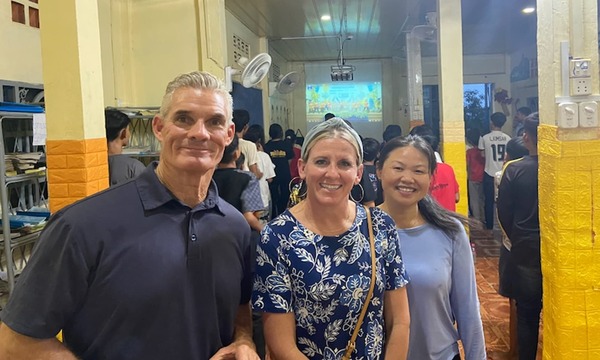Daniel Callis applied his fascination for urban studies and the arts in Barcelona at Can Serrat where he gained new ideas and visions for both programs. Embarking on a journey of reflection and a quest for new inspiration in an environment full of life, culture and history, Callis’ eyes were open to new ways of using art to express ideas and issues.
With the launch of the Urban Studies program in the 2009 fall semester, Callis and Brad Christerson, professors and co-directors of the new program, hope to combine their expertise into an integrative program for students who have an interest in urban issues.
While Christerson offers insight on areas related to sociology, Callis provides students an understanding of art and its impacting role in addressing worldly issues.
Thus, he did not hesitate on the idea of spending a month in Spain to interact with creative artists and writers to acquire further motivation and knowledge.
“It was an amazing time,” said Callis. “It was a sabbatical within a sabbatical. I lived in community in a 300 year old winery where studios were provided to work uninterrupted.”
He joined artists from all walks of life and countries such as Germany, Norway, Japan, Iceland, and England. Callis called it, “a community of creativity from around the world.”
The rich history dating back to 880 and the natural resources of Can Serrat allowed Callis to draw inspiration for the art he created.
“I took walks to the monastery to think about the week, pray and reflect,” said Callis. “On one trip to the monastery and to the Basal Cathedral, there were small anti-chambers that were opened and had sculptures of various saints. There were ornamental bars that were put to separate holy places from more holy places.”
Callis produced 24 paintings during his time in Can Serrat, finding himself creating unexpected pieces of work. He was opened to new influences of motifs, techniques and themes. The use of rendered lines in his paintings that are “austere and reductive” differed in comparison to the “playful and abundant” work that is normally reflected in his art. He used the motif of presenting lush background spaces with ornamental bars that force the viewer to look deeply into what lies behind the bars.
At the end of the five-week stay, an exhibition was held showcasing the works of various artists. The experience allowed him to expand his professional networks especially when he developed contacts with a photographer from London and an artist who will be a guest lecturer for the art department. Currently, Callis is talking with two galleries in Los Angeles to showcase his work from Can Serrat.
In describing his enthusiasm for art, he quotes Steve Martin: “Talking about art is like dancing about architecture.” Callis exudes a great excitement for creating art and teaching students about art, feeling that the art department is successful in helping students make use of their vocational calling.
“We’re at an interesting time in art, culture and higher art education,” said Callis. “We’ve been strategic in placing ourselves with curriculum development and faculty hires, embracing new directions and old practices, and inviting artists to do lectures and critique student work.”
Callis is an active professional in the art community whose work has been in international exhibitions in England and Italy. He has been a Biola faculty member since 1987 and maintains a studio in downtown Los Angeles. His work is influenced by social consciousness that informs the subject matter.
“I am particularly interested in visual sampling from urban/rural landscape interfaces,” said Callis. “Cues are taken from the eco-urban culture as a primary source material in order to create new visual constructs.”
He wants to provide students with the tools to become knowledgeable professionals by focusing on an “urban emersion” education with a vision for applying arts and witnessing in urban settings.
Callis feels Biola is building a reputation of having students who engage their education and faith to be salt in the world. He advises students to follow the calling God has given them and to be part of a community that provides accountability and support.
He refers to Stanley Kunitz’s poem from The Wild Braid to remind students that “…the body of work each artist produces / it is not an expression of the desire for praise or recognition or prizes / but the deepest manifestation of your / gratitude for the gift of life.”
Written by Jennifer Thach, Media Relations Intern. Jenna Bartlo, Media Relations Coordinator, can be reached at (562) 777-4061 or through email at jenna.l.bartlo@biola.edu
 Biola University
Biola University
_(1).jpeg)
.jpg)